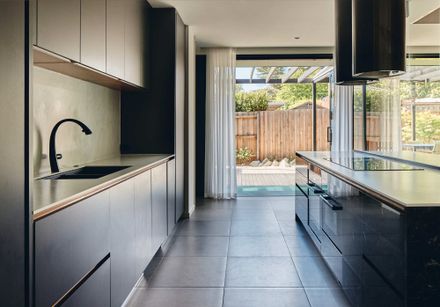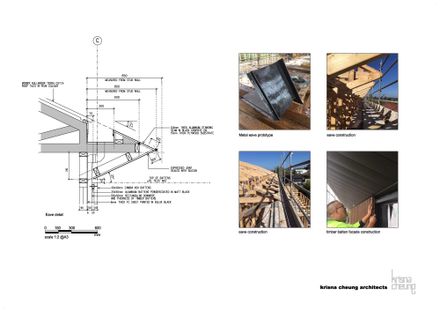ARCHITECTS
Krisna Cheung Architects
DESIGN TEAM
Welan Chu, Stewart Wu, De Lester Wong
MANUFACTURERS
Austral Brick Metallic Platinum Bricks, Mitchell Group Australia, Monier Roofing, Natural Hardwood
LANDSCAPE ARCHITECTS
Coxcape
CONTRACTOR / BUILDERS
Fine Home Construction
STRUCTURAL ENGINEER
Y.w Yong Structural Enigneers
YEAR
2023
LOCATION
Glen Iris, Australia
CATEGORY
Houses
'A home that reflects Asian warmth and lightness while integrating Melbourne's local context.' Set in the busy southeast suburb of Melbourne, the 'Tea House' hoped to capture comfort, cultural connection, and a sense of familiarity for a family of four.
DESIGN RESPONSE TO CONCEPT AND BRIEF
The client's passion for oriental architecture guides the balance of tradition and modernity. Each element and material instill tranquility, enveloping the home in an undisturbed atmosphere.
A heavy masonry brick on the ground floor contrasts with a lightweight timber batten façade above, creating a lantern effect.
Large timber doors lead inside, where dark brick walls invert the outdoor experience, emphasizing continuity.
The tearoom at the front reinterprets the traditional porch, where the family can enjoy morning sunlight while sipping tea—a homage to timeless rituals.
RESPONSE TO CONSTRAINTS
Contrasting the suburb's chaotic density, the house offers spaces of calm. However, the materiality seeks to describe its context, blending cultural nuances with local influences through locally sourced materials like Monier Nullarbor Terracotta Roof Tiles, Austral Brick Metallic Platinum Bricks, and Cambia Ash Timber Battens.
The grandparents' retreat required balancing separation with accessibility while avoiding isolation. Positioned at the rear, it integrates Melbourne's granny flat with a multigenerational design.
A central hallway, acting as the spine, links the retreat to the main house, allowing the grandparents their own space while keeping them connected to the family.
RELATIONSHIP TO CONTEXT AND BROADER PUBLIC BENEFIT
'The Tea House roots itself in place while appearing to float like a lantern, its timber batten façade illuminating the surroundings.' The design isn't only about the clients; it is about the local context.
It blends cultural influences with the local context, supplementing Melbourne's multicultural identity. We considered the roof forms and materials of the surrounding dwellings, taking cues from and complementing the context.
Outdoor nooks created from architectural push and pull prioritize privacy with timber screens limiting adjacent views. An open roof design offers an expansive sky, while the façade punctures frame glimpses of the streetscape and cityscape beyond, integrating it into the home.
A shared courtyard serves as a meeting point, strengthening connections among extended families or potential tenants.
Reflecting trends toward multi-generational living, this flexible design model is adaptable to suburban settings and addresses evolving housing needs.
SUSTAINABILITY
Our commitment to sustainability is reflected in the use of locally sourced materials, reducing environmental impact and supporting local economies.
North-oriented timber battens provide sun shading for thermal performance and privacy, while the traditional tiled roof offers insulation, enhancing energy efficiency.
Large green shrouded doors and motorized windows optimize cross ventilation, reducing reliance on mechanical cooling and promoting energy conservation.
Spatial continuity and positive energy flow are achieved by aligning the front entry door and a circular wall opening along an axis that connects rooms.



















